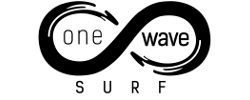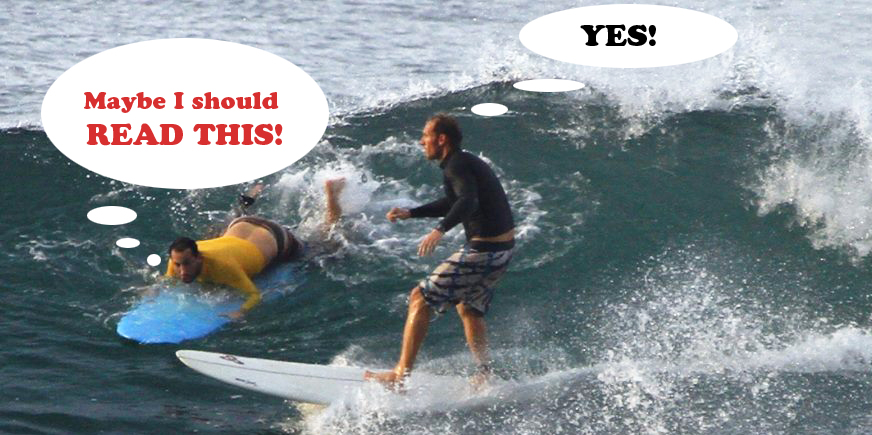Beginner surfer mistakes to avoid
Tyler Trafas
www.onewavesurf.com
August 23nd, 2015
—
Everybody makes mistakes on their first day of surfing, it’s just the way this sport is. If it was easy it wouldn’t be cool, it would be like the yo-yo, and nothing cool ever comes easy. You have to put in your time, your blood, sweat and tears. Pay the dues and you will reap the rewards, but don’t give up or bring yourself down when you make some of these mistakes that we have listed below. They’re the 5 most common mistakes everyone makes on their first day of surfing. We see them every day and thought maybe you would like to know what they were.
—
Board Control
The easiest way for you to get injured is by walking out with your board sideways, across your chest or stomach. Anytime someone gets hurt on their first day it’s usually this mistake. Either have your nose pointed straight to the ocean, or straight to the beach. Your board never needs to be sideways, especially in the impact zone (the area the waves are crashing). When carrying your board out to sea, have your board next to you, held with both arms, nose pointing towards the ocean, making sure the nose goes up and over the waves. If you don’t get your board up and over the oncoming waves, the waves will push your board back. Always have your nose pointed in the direction that you want to be going. If you can’t carry the board cause the water is too deep or the board is too heavy, push the board along side next to you, nose must be pointed out to sea, hands flat on the deck and aligned with the stringer. When an oncoming wave approaches jam that tail into the water, lifting the nose above the wave. Good board control is a must if you want to have a fun day of surfing.
Nose Diving/Pearling
Ah, the famous nose dive, also known as a pearl. Nothing can wake you up like a sudden rush of cold salt water punching you in the face at 7am. This is the most classic wipe out in the entire history of surfing. Everyone on this planet that has ever stood on a surfboard knows about the nose dive. To help prevent this wipe out the best way is to make sure that you are on your board correctly. Depending on the size of the surfer and the size of the board, you want to be on your board so that it is lying flat as possible on the ocean surface. Feet hanging slightly off the back or slightly above the tail. If you are too far back on your board, your nose will stick up, making it take more effort to move the board inefficiently. If you are lying too far forward your nose will dip under the surface and you will be wiping out in no time. If you do take a wave and see the nose start to dip, grab your rails, pull that nose out, and put weight on the back of the board. If you are riding a wave and you see your nose start to go in, put weight on your back foot. When you find where your body sits perfectly on the board, that is your sweet spot. Remember how a logo looks at that angle, or use something that you can use as a marker so that you are on your board correctly for the next wave. Laying on the board correctly is a definitive must for you to catch a wave correctly.
Surfing Too Close To The Crowd
Always find a spot to yourself, for your first few times surfing. Don’t have the herd mentality and go where the crowd is. At a beach break it is often not that different of conditions a few hundred yards down the beach from the crowd. When going out with a group of friends try to leave a distance of about 10 feet between you. I like to think of it like bowling alley lanes as well, you don’t want to be in someone else’s lane, their board coming fast at you has the potential to feel like a bowling ball. Make sure no one is in your lane before you take off on your wave as well.
Body Weight Distribution
That stringer going down the middle of your board from nose to tail, it’s your balancing point. Everything has to line up with that line. When laying down it needs to slice down the middle of your body from head to feet. When your feet hit the deck they need to be perpendicular to that line, remember to keep your knees bent. When you put your hands on the deck to start your pop up, they need to be symmetrically positioned next to your breast, if not your board will start to squirrel, making it that much harder to get to your feet.
Incorrect Paddling
Paddling is by far the most important part of surfing for a beginner. It’s what gets you into waves, the more waves you get, the better you will be at surfing, quite simple right? For a good strong paddle, make sure your hands are cupped and pretend you are scooping out the ocean. Fully extend your hands towards the nose and reel back towards your waist. Always one arm at a time, get a rhythm. You want your board to slice or plane through the waves. You want your arms to go along the side of the rails, not too far out. While paddling for a wave try not to move the rest of your body, only your arms. If your body is moving the board around a lot it will destabilize your board, making things more difficult for yourself when it comes time to stand up.
—
So there they are, don’t get too bummed if you have done these in the past or do them on the regular. Like we said everyone has had to deal with these. Learn from your mistakes and try to limit the wipe outs you have. Appreciate your advancements and accomplishments. Surfing is hard and it’s great because it’s hard, nothing in life worth doing comes easy. Besides how much cooler is surfing than playing with a yo-yo?

